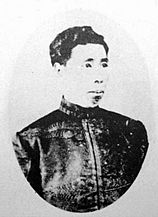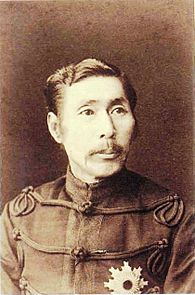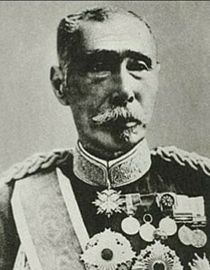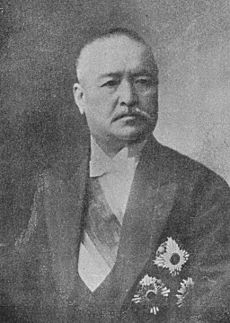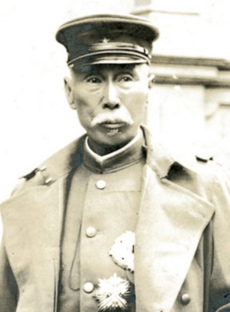Yamagata Aritomo facts for kids
Quick facts for kids
Gensui Prince
Yamagata Aritomo
|
|||||
|---|---|---|---|---|---|
| 山縣 有朋 | |||||
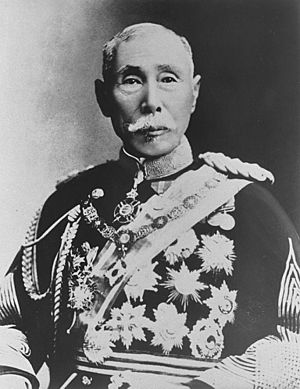 |
|||||
| President of the Japanese Privy Council | |||||
| In office 26 October 1909 – 1 February 1922 |
|||||
| Monarch | |||||
| Preceded by | Itō Hirobumi | ||||
| Succeeded by | Kiyoura Keigo | ||||
| In office 21 December 1905 – 14 June 1909 |
|||||
| Monarch | Meiji | ||||
| Preceded by | Itō Hirobumi | ||||
| Succeeded by | Itō Hirobumi | ||||
| In office 11 March 1893 – 12 December 1893 |
|||||
| Monarch | Meiji | ||||
| Preceded by | Oki Takato | ||||
| Succeeded by | Kuroda Kiyotaka | ||||
| Prime Minister of Japan | |||||
| In office 8 November 1898 – 19 October 1900 |
|||||
| Monarch | Meiji | ||||
| Preceded by | Ōkuma Shigenobu | ||||
| Succeeded by | Itō Hirobumi | ||||
| In office 24 December 1889 – 6 May 1891 |
|||||
| Monarch | Meiji | ||||
| Preceded by | Sanjō Sanetomi (Acting) | ||||
| Succeeded by | Matsukata Masayoshi | ||||
| Personal details | |||||
| Born | 14 June 1838 Kawashima, Chōshū Domain, Tokugawa shogunate, Japan |
||||
| Died | 1 February 1922 (aged 83) Odawara, Empire of Japan |
||||
| Political party | Independent | ||||
| Military service | |||||
| Allegiance | |||||
| Branch/service | |||||
| Years of service | 1868–1905 | ||||
| Rank | Field Marshal (Gensui) |
||||
| Battles/wars | Boshin War
Satsuma Rebellion
|
||||
| Awards | Order of the Golden Kite (1st class) Order of the Rising Sun (1st class with Paulownia Blossoms, Grand Cordon) Order of the Chrysanthemum Member of the Order of Merit Knight Grand Cross of the Order of St Michael and St George |
||||
| Japanese name | |||||
| Kanji | 山縣 有朋 | ||||
| Hiragana | やまがた ありとも | ||||
| Katakana | ヤマガタ アリトモ | ||||
|
|||||
Prince Yamagata Aritomo (born June 14, 1838 – died February 1, 1922) was a very important Japanese leader. He was a top military commander and served as Prime Minister of Japan twice. He was also a key member of the genrō, a special group of older, wise leaders who guided Japan after the Meiji Restoration.
Yamagata helped build Japan's modern army. He was the first Chief of Staff for the Imperial Japanese Army. Some historians even call him the "father" of Japan's military strength. During the later part of the Meiji Era, he was a powerful figure. After another important leader, Itō Hirobumi, died in 1909, Yamagata became one of the most powerful people in Japan, second only to the Emperor. He helped make many important decisions for Japan until shortly before his death in 1922.
Contents
Early Life and Education
Yamagata Aritomo was born on June 14, 1838. His birth name was Tatsunosuke. He was born in Kawashima, which is now part of Hagi in Yamaguchi Prefecture. His father was a low-ranking samurai soldier. He worked as an official in the town during peacetime.
Yamagata's mother passed away when he was only four years old. His strict grandmother raised him. His father taught him many things, including academics and poetry.
When he was 15, Yamagata had his coming-of-age ceremony. He started working as a small official in the Chōshū Domain. Later, he worked for a local governor, learning how a samurai official should do his duties.
He went to a private school called Shokasonjuku. This school was run by Yoshida Shōin. There, Yamagata became part of a secret group that wanted to overthrow the old government, the Tokugawa shogunate. He also became a commander in the Kiheitai, a special military group.
During the Boshin War (1867-1868), which led to the Meiji Restoration, Yamagata was a staff officer. This war changed Japan's government.
After the old government was defeated, Yamagata and another leader, Saigō Tsugumichi, went to Europe in 1869. They studied how European armies worked. Yamagata was very impressed by Prussia, a country that became strong quickly. He liked their ideas about military power and strong government.
When he returned to Japan, he was asked to create a national army. In 1873, he became the War Minister. He worked hard to make the new Imperial Japanese Army modern, just like the Prussian Army. He also started a system where all young men had to serve in the military.
Military Leadership and Influence
As War Minister, Yamagata helped create the Imperial Japanese Army General Staff. This office became a major source of power for him and other military officers. He served as the Chief of the Army General Staff several times between 1878 and 1905.
In 1877, Yamagata led the new Imperial Army against the Satsuma Rebellion. This rebellion was led by Saigō Takamori, who used to be Yamagata's friend.
Yamagata also encouraged Emperor Meiji to write the Imperial Rescript to Soldiers and Sailors in 1882. This important document guided the moral values of the Japanese Army and Navy until 1945.
Yamagata was given the highest military rank, field marshal, in 1898. He had a lot of experience leading in battles. He was the acting War Minister and Commanding General during the First Sino-Japanese War. He also led the Japanese First Army during the Russo-Japanese War.
Yamagata also played a key role in Japan's "Hokushin-ron" policy. This was a plan for national defense against Russia after the Russo-Japanese War.
Political Career and Impact
Yamagata was one of seven special political figures called the genrō. This word means "principal elders" or "senior statesmen." These genrō were very powerful and helped lead Japan's government. They were a small group of revolutionary leaders who worked together.
The genrō had no official government position. They were simply trusted advisors to the Emperor. But they made the most important decisions for Japan, like going to war or making peace. When a government resigned, they chose the next prime minister. These men helped Japan change from a farming country into a modern industrial and military power.
Yamagata had many supporters among army officers and people who believed in a strong military. He did not trust democratic ideas and tried to limit their power. He spent his later life protecting the special rights of the army and other government groups.
Yamagata held many important government jobs. In 1882, he became president of the Board of Legislation. As Home Minister (1883–87), he worked to control political groups and stop protests by workers and farmers. He also created a system for local government that Japan still uses today. In 1883, Yamagata became Lord Chancellor, a very high position in the government.
After the Cabinet of Japan was created, Yamagata became the third Prime Minister of Japan. His first term was from December 1889 to May 1891. During this time, he had to work with the Imperial Diet, which was a partly elected parliament. He also oversaw the creation of the Imperial Rescript on Education in 1890.
Yamagata served a second term as Prime Minister from November 1898 to October 1900. In 1900, he made a rule that only active military officers could be War Minister or Navy Minister. This rule gave the military a lot of control over who could form a government. He also passed laws that stopped political party members from holding important government jobs.
Yamagata also traveled as a diplomat. In 1894, he attended the crowning of Russian Czar Nicholas II. He also led a diplomatic trip to Moscow in 1896. This trip resulted in the Yamagata–Lobanov Agreement, which confirmed Japan's and Russia's rights in Korea.
Yamagata also served as President of the Privy Council from 1893 to 1894 and from 1905 to 1922. In 1907, he was given the title of koshaku (prince).
From 1900 to 1909, Yamagata was against Itō Hirobumi, who led the civilian political party. Yamagata used his influence through his close ally, Katsura Tarō. After Itō Hirobumi was assassinated in 1909, Yamagata became the most powerful statesman in Japan. He remained so until his death in 1922. Even though he retired from active politics after the Russo-Japanese War, he still chose future Prime Ministers.
However, his power was weakened in 1921. He strongly opposed the marriage of Hirohito (who later became Emperor) and Nagako. He said Nagako's family had color blindness. The Imperial family fought against Yamagata's pressure, and the couple eventually got married.
In 1912, Yamagata showed that the army could force a government to resign. There was a disagreement with Prime Minister Marquis Saionji Kinmochi about the military budget. This led to a serious problem called the Taisho Crisis. The army minister, General Uehara Yūsaku, resigned because the government would not give him the money he wanted. Saionji tried to find a replacement. Japanese law said that the army and navy ministers had to be high-ranking generals and admirals who were still active in the military. At Yamagata's urging, all eligible generals refused to join Saionji's government. This forced the government to resign.
Personal Life and Hobbies
Prince Yamagata was a very talented garden designer. The gardens he created are now seen as beautiful examples of Japanese gardens. One famous garden he designed is at the villa Murin-an in Kyoto.
Yamagata did not have any children of his own. So, he adopted his nephew, Yamagata Isaburō, to be his heir. Yamagata Isaburō later worked as a government official and cabinet minister. He also led the civilian government of Korea.
Awards and Honors
Yamagata Aritomo received many awards and honors throughout his life, both from Japan and other countries. These included:
- Japanese Titles:
* Count (1884) * Genrō (1895) * Marquis (1895) * Gensui (Field Marshal) (1898) * Prince (1907)
- Japanese Decorations:
* Grand Cordon of the Order of the Rising Sun (1877) * Grand Cordon of the Order of the Rising Sun, with Paulownia Blossoms (1895) * Grand Cordon of the Order of the Chrysanthemum (1902); Collar (1906) * Order of the Golden Kite, 2nd Class (1895); 1st Class (1906)
- Foreign Awards:
* Knight of the Royal Order of the Crown, 1st Class (German Empire) * Grand Cross of the Order of the Red Eagle (German Empire) * Grand Cross of the Royal Military Order of Our Lord Jesus Christ (Portugal) * Grand Cross of the Order of Saints Maurice and Lazarus (Italy) * Knight of the Order of the Iron Crown, 1st Class (Austria-Hungary) * Grand Cross of the Legion of Honour (France) * Honorary Member of the Order of Merit (United Kingdom) * Honorary Knight Grand Cross of the Order of St Michael and St George (United Kingdom) * Knight of the Order of St. Alexander Nevsky (Russian Empire)
See also
 In Spanish: Yamagata Aritomo para niños
In Spanish: Yamagata Aritomo para niños


